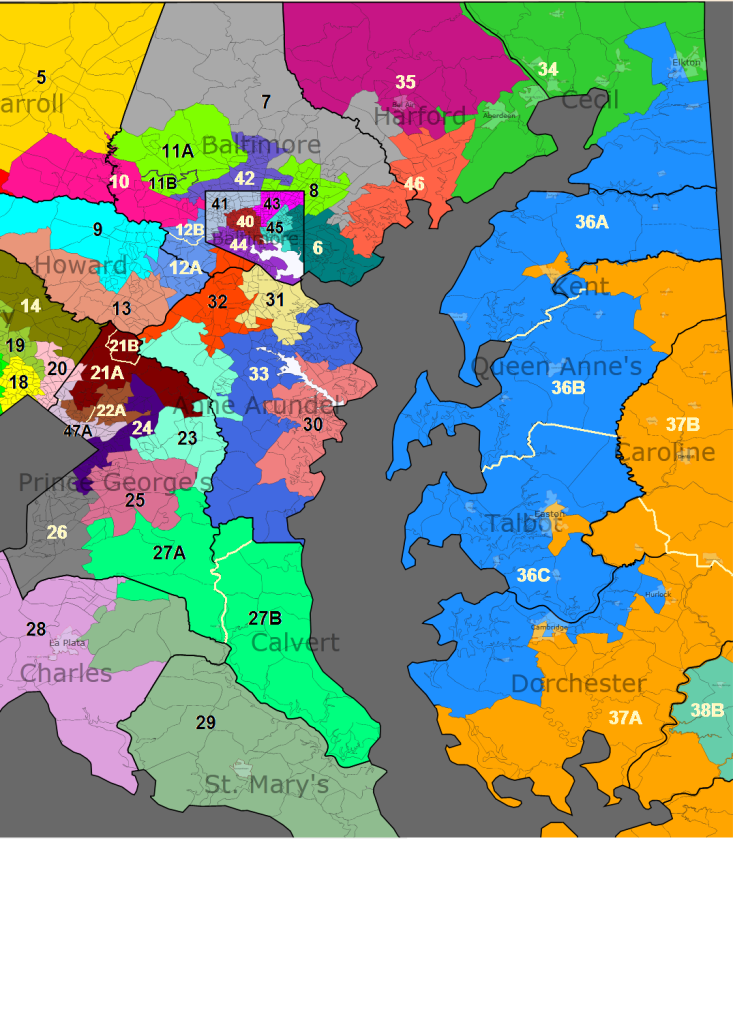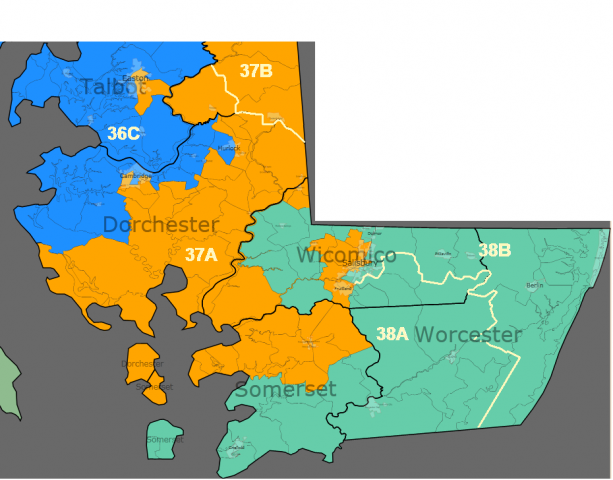Over the weekend Republicans in Maryland got together to conduct a little bit of business, enjoy each other’s company in a social setting, and elect a new Chairman. This is a first-person account of the proceedings.

Meeting for the first time in recent memory in “gorgeous” Prince George’s County, the mood was fairly upbeat but there was an undertone of controversy over internal party matters and tension between small and large counties. An encouraging sign, though, was seeing all 23 counties and Baltimore City present and accounted for at the Executive Committee meeting.
One break from tradition announced by Pelura in his Chairman’s Report was the consideration of rules for the Saturday convention. Rules 1 through 7 were assumed to be non-controversial and would be adopted separately from Rule 8, which set up a “compromise” voting system. That was expected to set off the most distress.
National Committeeman Louis Pope addressed the 24 county chairs and other assorted party officers by announcing money and finance would be “part of the mission” for 2010. It would require outreach to expand the donor base because fewer than 1% of Republicans ever participate in fundraising activities like Lincoln Day dinners or golf tournaments. Yet Pope predicted 2010 will be an “incredible” year for Republicans.
Joyce Lyons Terhes, National Committeewoman, chose to save the bulk of her remarks for Saturday but exhorted us to begin the 2012 campaign in 2010.
Both the College Republicans and Young Republicans counted as one of their achievements helping out the campaigns in Virginia and New Jersey. Several good speakers had addressed the various local campus branches of the College Republicans while the Young Republicans had the pressing conflict of whether to get involved more in the local or national campaigns upcoming. In either case YR’s were ready and willing to help, according to their spokesman Moshe Starkman.
Patt Parker made her final report for the Maryland Federation of Republican Women and spoke about successful training sessions and reaching out to candidates for assistance through unique means.
Each of the 23 counties and Baltimore City then gave a short report. One thread running through a number of county reports was the relatively new influence of local Americans for Prosperity chapters and how we could work with them to advance common principles.
After county reports, the Executive Committee went into executive session to approve the 2010 budget. Those who didn’t stay drifted off to one (or more) of the numerous hospitality suites or ballrooms, where food and drink were lavished on attendees.

Billed as the “Hogan/Pappas Unity suite”, a current and former GOP candidate for governor hosted the largest event.

By the way, don’t count Mike Pappas completely out of this or future elections – I spoke to him on Saturday and he’s holding on to the money he had left over in his campaign coffers for now.
Most attendees also had one or more of the green Hogan stickers off his table.

Two other 2010 candidates had their own hospitality suites. Andy Harris had the better food (man was the cheesecake good!), but Charles Lollar had the nicest sign so that gets the picture here.

Another tag team suite came from Maryland Senate Republicans.

It’s a nice sign, but already out of date with the resignation of Sen. Janet Greenip. Hopefully this time next year they’ll need a bigger sign to place several additional names. 20 would be a nice round number and I think it’s an attainable goal.
Chair candidate Audrey Scott also had a suite. But more interesting was the idea that not everyone was happy with the limited selections for Chairman, as one person took out his or her frustration on the sign in the elevator.

Two of the leading candidates challenging Sen. Barb Mikulski were also campaigning at the event. Here’s Jim Rutledge speaking to a supporter.

Fellow Senate hopeful Dr. Eric Wargotz was also working the rooms, but shrewdly had a table filled with his campaign items. Plenty of people sported the red, white, and blue Wargotz logo.

And proving that capitalism isn’t dead, even in this age of Obama, there were several vendors hawking their wares.




The Maryland Young Republicans tried their hand at making money, too, conducting a silent auction outside their hospitality suite.

If you’re a political junkie, the Friday night of the convention is actually an opportunity to meet and greet a number of candidates and incumbents in a relaxed, non-formal setting plus enjoy good food and drink. It’s our little respite before we go to work Saturday morning.
But many socialize just a little longer early Saturday by attending the breakfast hosted by the Maryland GOP. The featured speaker was newly-elected Brentwood mayor Xzavier Montgomery-Wright.

Telling us that “unity is important” and “must be our immediate goal”, Montgomery-Wright stressed new leadership, modernization, and communication during her campaign, which became much easier when her two main challengers early on dropped out, leaving her unopposed. Yet Xzavier continued going door-to-door even after her opponents withdrew because she valued the opportunity to meet with her constituents face-to-face.
Her key achievements thus far were re-establishing the town’s police force, which was disbanded in 1972, and creating a Facebook page for the town, which she’s updated frequently as a way to extol the town’s benefits at little cost. Montgomery-Wright noted that “social networking is the next generation” of communication.
Turning to her Republican roots, Xzavier began her adult life as a Democrat but switched parties once she became established in business, claiming “I refuse to be a product of the government.” She stated that Republicans could elect qualified candidates in 2010 but opined that people were voting candidates and issues moreso than party. (She won a non-partisan election.)
Breakfast over, we turned to the business at hand.

Unlike the previous convention, where 3 counties either didn’t attend or boycotted because of a perceived lack of respect from larger counties who controlled the voting process, we had nearly a full slate in the hall – close to 90 percent either attended or had a proxy. It was the best attendance in recent conventions.
We did things a little differently, hearing from our featured speaker near the beginning of the program. One reason was to accommodate the man who introduced him.

Bob Ehrlich proclaimed the “successes” of Virginia, New Jersey, and the town hall meetings over the summer and pointed out we needed to grow the GOP and appeal to independents. On the other hand, Democrats had what they called the “ten-zero” plan ready to put in place should they maintain power next year.
But he was most complimentary to the man he was introducing, Rep. Roscoe Bartlett, and lauded Bartlett for mentoring him during his time in Congress.

Bartlett’s theme came in the form of a question – why are we so darn fortunate in this country? However he had “enormous concern” for its future, particularly when Congress regularly violates the 9th and 10th Amendments. “Much of what we do in Congress is a violation of the Constitution,” asserted Bartlett. Roscoe also pointed out he doesn’t hunt or shoot a gun but still is a “fervent” supporter of the 2nd Amendment.
Reflecting on his nine terms in Congress, Bartlett remarked that he was proud of running almost completely clean campaigns but “regrets” doing the one negative ad which was done in all those campaigns.
Once Bartlett completed his address, it was time to get down to business, starting with the rules. As expected, rules 1-7 passed in a voice vote. But Rule 8 aroused a little bit of controversy as expected, with passionate speakers on both sides. And don’t think I’m going to forget being cut off from having my voice heard in the debate by the speaker prior to me who called the question. Just try to run for anything, pal.
As I said when I returned to my seat, “that’s okay, I have a blog.”
Rule 8, the so-called “compromise”, passed by voice vote but upon the chair’s discretion was also done by a roll call vote. The results were 201 in favor, 19 against, and 6 abstaining (all 6 were from Baltimore City.) The only county which voted properly against Rule 8 was my county, Wicomico, by a 6-1 margin.
I look at the situation this way – if small counties want to cut their own throat and throw away the power they have, I suppose that’s their right but I’m going to fight it tooth and nail. It’s interesting that the large counties wouldn’t give us the time of day until WE figured out the rules actually worked in our favor. And all that was necessary was 1/3 of the vote plus 1 to preserve the role of small counties.
So the convention adopted a hybrid system which gave each county a base of votes plus a factor based on their votes for John McCain. One man, one vote is so much simpler – fortunately, these rules are for one convention only.
Then we had a voice vote on four resolutions which passed nearly unanimously. I would have certainly preferred to consider all four on their own merits because I saw two as “trap” resolutions and the other two as pretty much non-controversial (they increased the number of Central Committee members in Wicomico and Worcester counties from seven to nine.)
The “trap” resolutions were sponsored at least in part by Montgomery County, which seems to be our nemesis. One was an effort to straighten out the number of Central Committee members by next January 31st and the other was a resolution to conduct no business at our Spring Convention next year. I know exactly why that one was put in, and it’s not for the reason stated. So I said “no” to the whole block.
We also heard reports from our national Committeewoman and Committeeman.
Joyce Terhes expanded her remarks from the previous night, calling 2010 the opportunity to repeat a successful year in 1990. But “the new chair cannot do it alone”, and Terhes called on us to organize precincts, raise money, raise our voices, and prepare for early voting.
Louis Pope noted that Barack Obama had visited more countries in his first year than any other President, but being an “agent of change” did nothing to help the economy. Pope opined that “Americans said enough is enough” with the 2009 elections, and if we could fill the ballot with candidates who could win and give them enough support this could be a “phenomenal” year. O’Malley and Obama were “two of the best friends the Republican Party has.”
At long last, it was time to hear from candidates who wanted to be our new Chairman.
Audrey Scott told us independents and Republicans needed to work together, and the results in New Jersey and Virginia were “very, very good news for Maryland.” In 2010 “national politics will be on our side” as it was a “once in a lifetime opportunity.”
Daniel Vovak countered by allowing those who nominated him to tell the convention why they did so. (To be honest, he only expected to speak three minutes and not ten.) It was most noteworthy that he “came as myself”, eschewing the wig he’s most famous for wearing.
As expected, though, Audrey Scott won handily, carrying all but one county. Yep, that was us. 205 voted for Scott and 16 for Vovak (5 of 7 from Wicomico went Vovak). Five members did not vote. It worked out to 609-45 under the “improved” voting system.
I have nothing against Scott, I’m just not convinced that as the “establishment” candidate she’ll pay much attention to the rural counties. Then again, I didn’t vote for Jim Pelura either and he turned out to be one who did address our concerns.

In the spirit of cooperation, Mike Collins of Anne Arundel County began a parade of people willing to donate to the party. All told, the impromptu effort raised $4,000 for the party coffers, which included donations from two county committees.
Scott has her work cut out for her, but among the things she stressed was better communication through the new social media. That means she should take extra care to keep things progressing in a manner one blogger approves.
We’ll see how she’s faring when next we meet in the spring of 2010. How about a good old Eastern Shore convention for starters?




